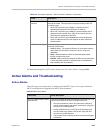
Polycom RealPresence Collaboration Server (RMX) 1500/2000/4000 Administrator’s Guide
H-68 Polycom, Inc.
SIP TLS: Registration transport
error
This alarm indicates that the communication with the SIP server
cannot be established. Possible causes are:
• Incorrect IP address of the SIP server
• The SIP server listening port is other than the one defined in
the system
• The OCS services are stopped
Note:
Sometimes this alarm may be activated without real cause.
Resetting the MCU may clear the alarm.
SIP TLS: Registration
handshake failure
This alarm indicates a mismatch between the security protocols
of the OCS and the MCU, preventing the Registration of the
MCU to the OCS.
SIP TLS: Registration server not
responding
This alarm is displayed when the MCU does not receive a
response from the OCS to the registration request in the
expected time frame. Possible causes are:
• The MCU FQDN name is not defined in the OCS pool, or is
defined incorrectly.
• The time frame for the expected response was too short and
it will be updated with the next data refresh. The alarm may
be cleared automatically the next time the data is refreshed.
Alternatively, the OCS Pool Service can be stopped and
restarted to refresh the data.
• The MCU FQDN name is not defined in the DNS server. Ping
the DNS using the MCU FQDN name to ensure that the MCU
is correctly registered to the DNS.
SIP TLS: Certificate has expired The current TLS certificate files have expired and must be
replaced with new files.
SIP TLS: Certificate is about to
expire
The current TLS certificate files will expire shortly and will have
to be replaced to ensure the communication with the OCS.
SIP TLS: Certificate subject
name is not valid or DNS failed
to resolve this name
This alarm is displayed if the name of the MCU in the certificate
file is different from the FQDN name defined in the OCS.
Note:
Occasionally this alarm may be activated without real cause.
Resetting the MCU may clear the alarm.
Table H-9 New Active Alarms (Continued)
Alarm Code Alarm Description


















